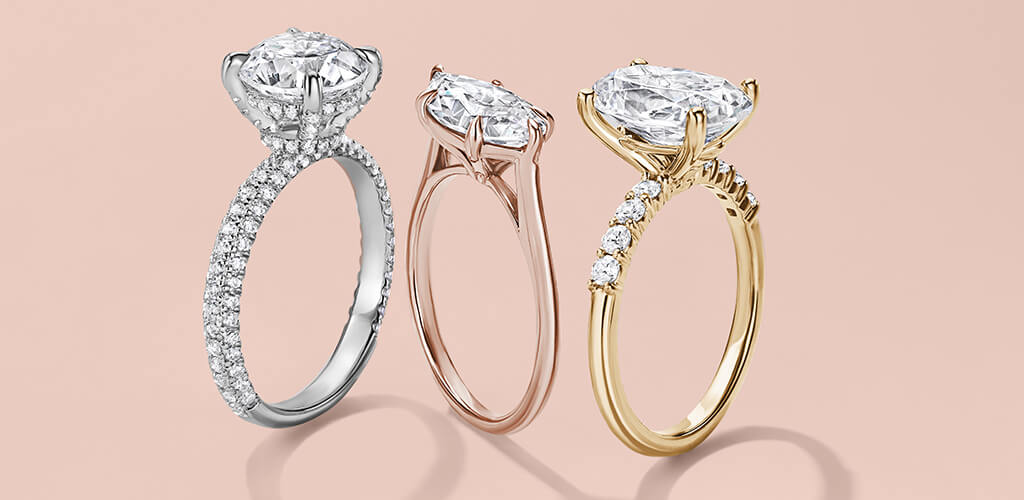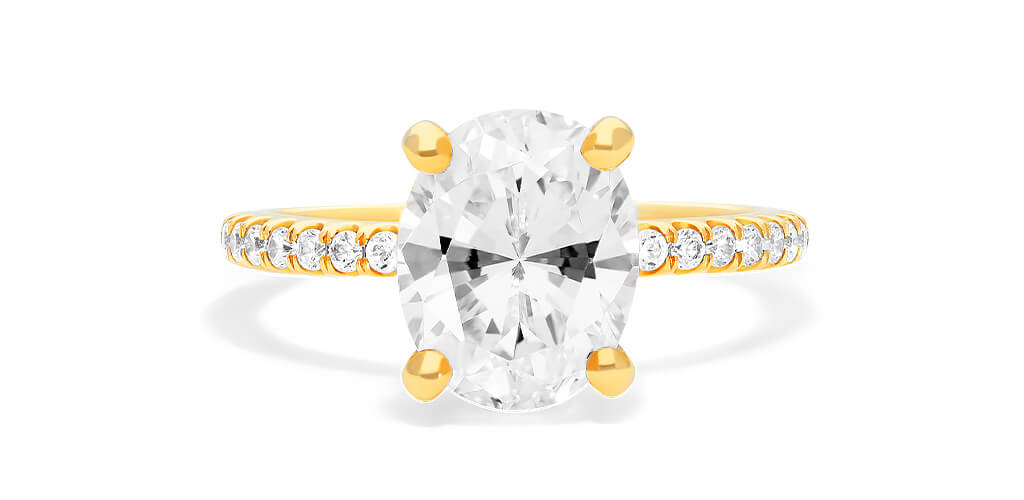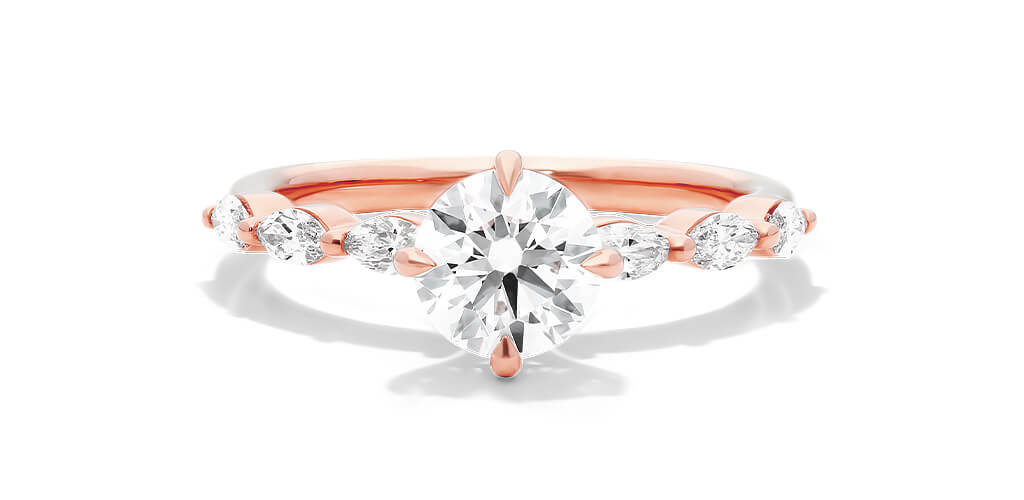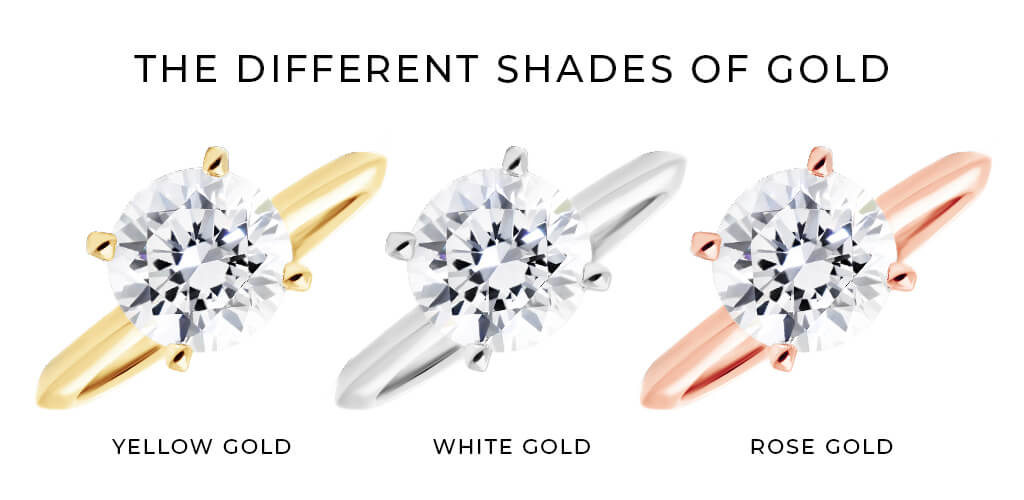Picking the right metal for your engagement ring means considering a few important factors like how the metal color will affect the overall look of the ring, how it feels on, and its longevity. We’re taking a deep dive at the different metal options available for engagement rings and how to pick the best one for you.
What Is Yellow Gold?
Yellow gold is prized for its timeless appeal, offering a classic, warm hue that’s been a favorite for generations. It is an alloy of pure gold, silver, and copper, providing the perfect balance between strength and malleability for your dream ring.
Benefits of Choosing Yellow Gold
- Timeless appeal and traditional look.
- Complements warmer skin tones beautifully.
- Less maintenance compared to white gold.
What Is White Gold?
White gold offers a modern, chic look, making it a popular choice for contemporary women’s engagement rings. It is created by alloying pure gold with white metals like palladium or nickel, and is often coated with rhodium for extra shine and durability.
White Gold vs Platinum
- Appearance: Both metals offer a similar silvery sheen, but white gold engagement rings tend to have a brighter finish due to the rhodium plating.
- Durability: Platinum engagement rings are denser and more durable, making it ideal for securing precious stones.
- Cost: Platinum is generally more expensive than white gold due to its rarity and higher density.
What Is Rose Gold?
Rose gold has a unique, pinkish hue that comes from a blend of pure gold and copper. It stands out for its romantic, vintage appearance and has become increasingly popular for those seeking a distinctive look. Check out these popular custom design rose gold engagement rings for inspiration.
Rose Gold vs Yellow Gold
- Color: Rose gold has a pink tone, while yellow gold is distinctly golden.
- Durability: Both are durable but will show wear over time; rose gold may require less frequent polishing due to its copper content.
- Style: Rose gold offers a more modern twist and is great for unique, contemporary designs.
What Is Platinum?
Platinum is a white metal known for its exceptional strength and durability. It’s highly sought after for engagement rings due to its heavy weight and resistance to wear. Its natural white color does not fade or tarnish over time, making it perfect for showcasing diamonds.
What Is 14K Gold?
14K gold consists of 58.3% gold and 41.7% alloy metals like silver, copper, zinc, or nickel. This alloy composition makes 14K gold more durable than its higher-karat counterparts, which is why it’s often recommended for engagement rings and other jewelry intended for everyday wear.
What Is 18K Gold?
18K gold contains 75% gold, making it purer than 14K. This higher gold content gives 18K gold a richer, more vibrant yellow color. It’s particularly popular in fine jewelry and is often chosen for its aesthetic appeal and luxurious feel.
14K Gold vs 18K Gold
- Durability: The higher alloy content makes 14K gold more resistant to wear and tear.
- Affordability: Less pure gold means lower cost, making 14K a more budget-friendly option.
- Less Prone to Scratching: 14k gold’s harder surface means it’s less likely to get scratched compared to 18k gold.
- Rich Color: The higher percentage of gold in 18k gold creates a deeper yellow tone that is more striking than 14K gold.
- Softer and More Malleable: 18k gold is softer making it more prone to scratches, it also allows for more intricate designs in jewelry making.
- Prestige: Higher gold content in 18k gold adds prestige and value, making it a preferred choice for luxury jewelry.
Things to Consider When Choosing Your Metal
When selecting the perfect metal for your engagement ring, consider how the characteristics of each metal align with your budget, personal style, and lifestyle.
These factors will help guide your decision and ensure that your ring looks stunning and suits your day-to-day life.
Budget
- Affordability: Gold is generally more affordable than platinum, with white gold and yellow gold engagement rings being roughly comparable in price.
- Long-term Value: Platinum is more expensive upfront but may require less maintenance over time, which could save money in the long run.
- Personal Style:
- Color Preferences: Do you prefer the classic yellow of traditional gold, the modern sheen of white gold, or the distinctive pink hue of rose gold? Maybe the sleek, white luster of platinum appeals to you.
- Design Considerations: Consider how the color of the metal complements the gemstone(s) of the ring. Platinum and white gold are excellent for making diamonds appear brighter, while yellow gold suits vintage styles.
Lifestyle
- Durability Needs: If you lead an active lifestyle or work with your hands, platinum’s durability and scratch resistance might be beneficial.
- Maintenance Willingness: If you’re not keen on frequent maintenance, consider platinum for its low upkeep compared to gold, which may require periodic re-polishing and re-plating.
- Allergies: For those with sensitive skin, platinum is a hypoallergenic option that avoids the skin irritations sometimes caused by the nickel in white gold.
Which Is the Best Metal for Metal Allergies?
For those with sensitive skin or metal allergies, selecting the right metal for an engagement ring is crucial to ensure comfort and avoid allergic reactions. Here’s what you need to know about hypoallergenic metals:
Platinum:
- Hypoallergenic Properties: Platinum is naturally hypoallergenic, making it an excellent choice for those with allergies to other metals.
- Purity: Because it’s typically used in jewelry at 95% purity, platinum rarely causes skin irritation, unlike other metals that may include allergenic alloys.
Golds:
- Yellow Gold: Higher karat yellow gold (18K and above) is less likely to cause allergic reactions because of its higher gold content and lower percentage of other metals like nickel or zinc, which can irritate sensitive skin.
- White Gold: Often alloyed with nickel to achieve its white color, white gold can cause allergic reactions in some people. If you love the look of white gold, opt for versions alloyed with palladium instead of nickel, or consider having the ring coated with a hypoallergenic rhodium plating, keeping in mind that it will need periodic re-plating.
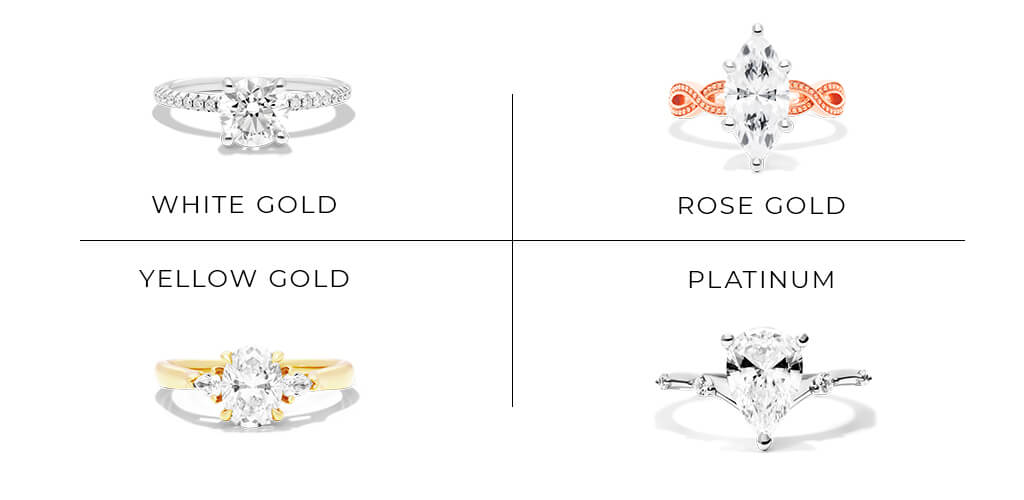
Final Thoughts
We hope you found this guide helpful. By understanding the characteristics of each metal, we’re sure you can make an informed choice that aligns with your personal style, budget, and lifestyle needs. Need more information before you make your decision? Chat with our team 24/7!

